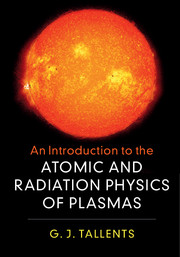Book contents
- Frontmatter
- Contents
- Preface
- 1 Plasma and Atomic Physics
- 2 The Propagation of Light
- 3 Scattering
- 4 Radiation Emission in Plasmas
- 5 Radiation Emission Involving Free Electrons
- 6 Opacity
- 7 Discrete Bound Quantum States: Hydrogen and Hydrogen-Like Ions
- 8 Discrete Bound States: Many-Electron Atoms and Ions
- 9 Discrete Bound States: Molecules
- 10 Radiative Transitions between Discrete Quantum States
- 11 Collisions
- 12 Collisional-Radiative Models
- 13 High-Density Plasmas
- Appendix Vectors, Maxwell's Equations, the Harmonic Oscillator and a Sum Rule
- References
- Index
4 - Radiation Emission in Plasmas
Published online by Cambridge University Press: 21 February 2018
- Frontmatter
- Contents
- Preface
- 1 Plasma and Atomic Physics
- 2 The Propagation of Light
- 3 Scattering
- 4 Radiation Emission in Plasmas
- 5 Radiation Emission Involving Free Electrons
- 6 Opacity
- 7 Discrete Bound Quantum States: Hydrogen and Hydrogen-Like Ions
- 8 Discrete Bound States: Many-Electron Atoms and Ions
- 9 Discrete Bound States: Molecules
- 10 Radiative Transitions between Discrete Quantum States
- 11 Collisions
- 12 Collisional-Radiative Models
- 13 High-Density Plasmas
- Appendix Vectors, Maxwell's Equations, the Harmonic Oscillator and a Sum Rule
- References
- Index
Summary
In this chapter we initially concentrate on radiation in thermal equilibrium. We derive the Planck radiation law for an equilibrium radiation field by considering the density of photons in a black-body cavity. As well as being applicable to many astrophysical and some laboratory plasmas, the concept of a radiation field in thermal equilibrium is useful in deducing the relationships between inverse processes interacting with a radiation field. The three possible radiative processes (spontaneous emission, photo-excitation and stimulated emission) between two quantum states in an atom or ion in the presence of an equilibrium radiation field are examined. It is shown that a simple thought experiment, where the rates of the three radiative processes are in balance with an equilibrium radiation field, leads to universal relationships between the radiative rates.
The Planck Radiation Law
If the radiation and electrons in a medium have many interactions through emission and absorption, the radiation field becomes thermalised and can be regarded as having a temperature equal to that of the electrons. In this section, we calculate the form of the thermalised radiation known as the Planck radiation intensity.
An equilibrium radiation field is a collection of photons which follow the rules of statistical mechanics for a collection of bosons. We need to calculate the density of modes for light in a steady-state system. We imagine a cube in space with perfectly conducting (and hence perfectly reflecting) walls and sides of length L. Such a volume with an assumed radiation energy in equilibrium with the walls is known as a black-body cavity (though in inertial fusion work the German word hohlraum is often used).
The Density of Modes
The wavelengths ƛ of light that can exist in a steady state inside a conducting cube of sides L are quantised by the condition that a half-integer number of wavelengths only can exist in directions perpendicular to the walls. Otherwise, the oscillating electric field for the light causes transient interference effects and a steady-state solution for the radiation field does not exist.
- Type
- Chapter
- Information
- Publisher: Cambridge University PressPrint publication year: 2018



